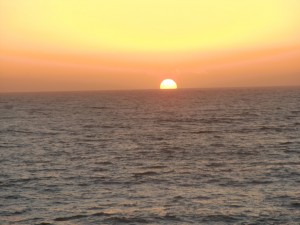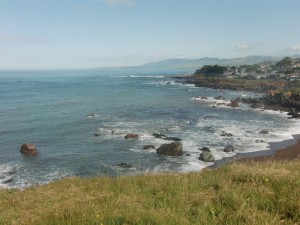CAMBRIA BY THE SEA
CAMBRIA BY THE SEA
By Charles N. Stevens
Photos by Dolores Seidman
Today we will take a trip to Cambria, a lovely seacoast town halfway between Los Angeles and San Francisco. After enduring the morning traffic on the freeways, we finally slip free and are on our way north on Interstate 5. The weather had been partly cloudy when we left Monterey Park, but the clouds thickened and darkened as we reached Gorman on the ridge route. What began as a sprinkle and even a light mist, morphed into a driving rainstorm with heavy drops battering our windshield. Driving conditions deteriorated, the rain, fog and the spray churned up by trucks cutting down on visibility. It was difficult to see the cars ahead, especially if they had no tail lights. It was a time for white knuckles on the steering wheel.
Rain slashed down all the way through Tejon Pass as low clouds swirled along the mountain ridges, but it lightened up as we entered the San Joaquin Valley, the gray overcast still dripping. We turned westward on Highway 46, passing through the Paso Robles vineyards and its array of famous wineries. At Paso Robles we jogged to Highway 41 which led us over a low mountain range toward the coast. Again we plowed through heavy downpours, but when we reached Highway 1 along the coast, the clouds swept away to the east and the sun shone in a clear blue sky. It was like entering a paradise.
We were soon treated to a scene of hills covered with trees, the Monterey pines, that flourish naturally in the Cambria area. Ignoring the quaint town of Cambria, at first, we turned down toward the shore, Moonstone Beach, with its long line of attractive motels. We had reservations at the Sea Otter Inn, but all the motels are of excellent quality. Here we met our friends who had driven down from the north.
As soon as we unpacked, we walked out on the bluff only yards from the pounding waves. Strolling is easy, as the town has constructed wooden walkways all along the bluff, paths that lead through wild flowers and green brush as well as wind-sculpted trees. We followed the walkways to magnificent views of the waves crashing on the rocks below. Sea gulls cruised by and song sparrows sang in the bushes.
One spot that looks out over the sea seemed especially made for watching the sun set in the west. Later, at the end of the day, we stood there gazing at the reddish-orange sun as it dipped toward the gray ocean. We watched it change shape, sometimes looking like a brilliant tea cup, and then it was gone.
Together with our friends, we drove up through the village of Cambria, past the quaint shops and antique stores, to Linn’s Restaurant. Housed in an attractive brick building, it offers good American fare as well as a bakery, its glass cases filled with mouth-watering pies and cakes. We were quite satisfied with our meal.
Cambria has quite a history. Long ago, the Chumash Indians found the area around what is now known as Cambria much to their liking, especially sea that gave them an abundance of fish. In 1769 the Portola Expedition passed through, camping for a while and gladly accepting food from the Indians. In 1862 cinnabar, the ore that produces mercury, was discovered, and Cambria became a boom town. Mining folded when the price of mercury dropped. A more recent bit of history occurred in 1941 when the Union Oil tanker, Montebello, was sunk by a Japanese submarine right off the coast. Citizens of Cambria helped rescue the crew.
But, back to the present! What I like to do is find a spot along the bluff where I can watch the waves with all their energy and rhythm sweep in and blast themselves against the rocks. I spot seals sleeping on the rocks, looking much like giant slugs. Now and then I hear one bark before going back to sleep. From the same place I can view a crescent beach strewn with driftwood, what I call the bleached bones of the sea. I notice a group of young people walking among the driftwood, on their way to the tide pools that hold a menagerie of sea creatures.
But mostly I enjoy walking along the wooden pathways, breathing in the fresh air as I listen to the sounds of the sea. That’s Cambria to me.

Cambria is a wonderful spot to watch the sun meet the sea
.

Waves constantly beat against the rocky coast.

The coastline and bluffs at Cambria form this beautiful scene.

The city has built these comfortable wooden walking paths along the bluffs.
MONTEREY PARK AUTHOR PUBLISHES 4th BOOK – Seeking More of the Sky: Growing Up in the 1930’s:
Charles “Norm” Stevens, a 43 year resident of Monterey Park has recently published his 4th book: Seeking More of the Sky: Growing Up in the 1930’s. This is the story of a young boy growing up in Inglewood, California in the l930’s. This was a time during the depression when unemployment was affecting many and the banks were closed, while the clouds of war were gathering in Europe. But he was lucky enough to be raised in a loving family, the power of that love reflected throughout his stories.
Stevens is the author of three previous books about his experiences during WWII:
An Innocent at Polebrook: A Memoir of an 8th Air Force Bombardier (Story of his 34 bombing missions from his base at Polebrook, England over Germany and France)
The Innocent Cadet: Becoming A World War II Bombardier (A prequel to the first, telling of his training in the U.S. before going overseas into combat.)
Back from Combat: A WWII Bombardier Faces His Military Future from Combat: (This book details the time from when he returned from combat in England until the end of the war.)
He is known to the readers of The Citizen’s Voice as the author of Travel Log Articles including “Cruising the Rhine and Mosel”,” Best of the West”, “In Search of Snow” , “From Paris to Normandy on the Seine”, and “Exploring New York”. He is retired, having taught for 32 years, primarily in the Montebello Unified School District.
Those interested in purchasing an autographed copy of any of his books, may contact the author at 323-721-8230 or Normstevens24@gmail.com.



